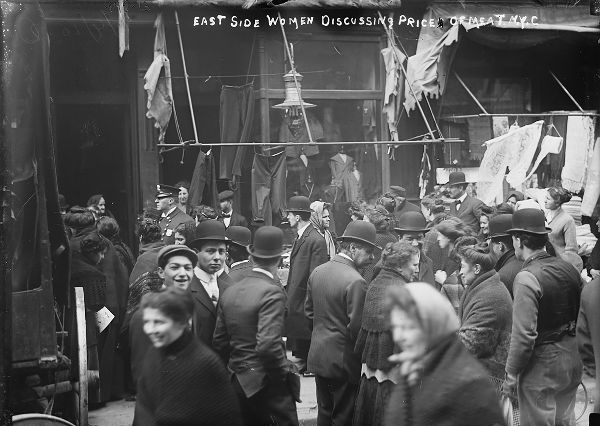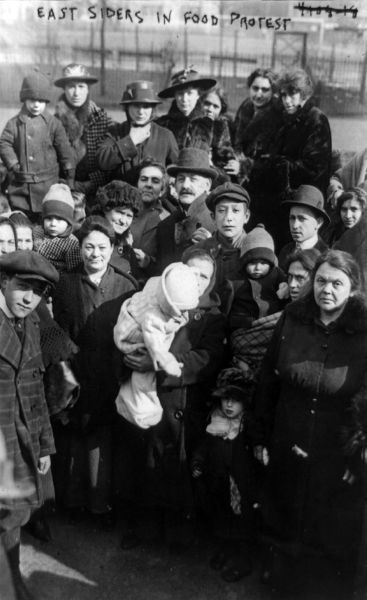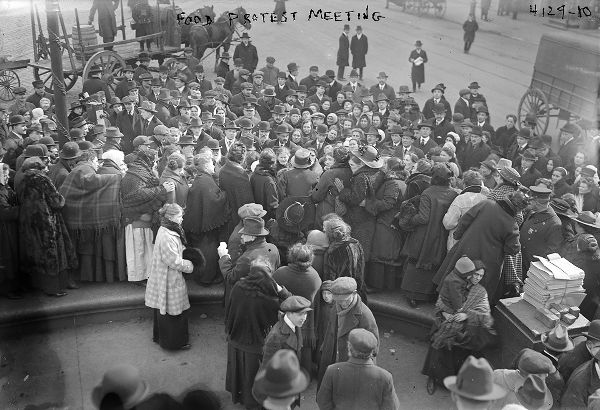21
A Great Victory for the American People
The Beef Trust remained capable of collusion and manipulating prices for many years after the Supreme Court decision in Swift & Co. v. United States. One key vehicle for coordination was the National Packing Company, described by the federal government as a “strong community of interest among four of the six leading companies in the packing-house business.” It came in for Federal Trade Commission scrutiny in 1910 and 1911, and although its directors were absolved of criminal charges, it was finally dissolved under the direction of the Justice Department in 1912.1
But even that didn’t spell the end of the Beef Trust, at least in the public mind. Collusion became more difficult, but not impossible, and hence the price of meat, and therefore that of kosher meat, continued to fluctuate, seemingly independently of the law of supply and demand. When it became too high, as it did from time to time, boycotts were organized by local Jewish communities. These occurred not only in Manhattan and Brooklyn, but also in Philadelphia; Boston; Cleveland; Detroit; Baltimore; St. Louis; Wilmington, Delaware; Providence, Rhode Island; New Bedford and Brockton, Massachusetts; and Newark, Bayonne, and Paterson, New Jersey.
There was a certain sameness to the protests, and most looked a lot like the 1902 New York boycott, only on a smaller scale. They generally pit butchers against wholesalers and women against butchers, and saw women organizing, canvassing, and picketing. They saw committees and mass meetings and butchers closing until prices came down. None of them lasted long, but they could be quite bitter. They usually involved the police, and often degenerated into pulled hair, flesh wounds, broken windows, and kerosene-soaked meat.
In April 1910 a meat riot foreordained by the Chicago meat barons by an arbitrary, two-and-a-half cent per pound jump in prices began in Harlem. It was notable for the leadership of forty-eight-year-old Anna Pastor, the mother of Rose Pastor Stokes, the well-known Tageblatt columnist and social activist. At a gathering of Jews on Forsyth Street on April 7, she spoke up for the butchers. “The butchers are victims of the Meat Trust,” she insisted. “They would like to sell meat cheaper, but I positively know they can’t do it at the present wholesale price.” She advocated permitting them to dispose of their stocks of meat before joining the boycott. It was agreed they would close the following Monday, April 11, but some were pressured by demonstrators into doing so earlier.2
By Monday, there was little daylight between the women and the butchers. The Hebrew Retail Kosher Butchers’ Protective Association called a halt to the purchase of meat from the wholesalers, and some twenty-five hundred of the three thousand–odd butchers in greater New York honored it. That in itself didn’t stop the breaking of windows and some scattered attacks, but things quieted down once most shops in Harlem, the Bronx, Brooklyn, and the Lower East Side and in Newark and Bayonne in New Jersey were shuttered. A large contingent of butchers even marched on the slaughterhouses to demand lower prices. Abattoir employees shut their doors and windows and stood behind them brandishing knives and cleavers, but there was no violence.3
A moratorium on the boycott was called to allow Jewish families to eat kosher meat on the Passover holiday, which began on April 23, and the protest does not seem to have regained much steam after that, though there were outbreaks in other cities throughout the summer.

32. A crowd discussing the price of meat in front of East Side shops, 1910. Source: Library of Congress, Prints and Photographs Division, George Grantham Bain Collection, LC-DIG-ggbain-04611.
Things heated up in early June 1912 when the wholesale price of chuck rose once again, forcing the retail price up to eighteen cents. This time the first protest action was in Brooklyn, but it eventually spread to the East Side and the tactics were the same: squads of women patrolling the markets with kerosene at the ready. East Siders voted at two neighborhood meetings to support a boycott, and the butchers plowed in behind them a few days after that. By now they knew from bitter experience that there was no percentage in doing anything else. Remaining open was not an option unless they relished having their windows broken and their stock destroyed.
This time the butchers also asked the shoychtim and the 150-odd mashgichim who worked under them at the abattoirs to walk out in solidarity. The action spread to Chicago, Philadelphia, Boston, and elsewhere before enthusiasm ebbed during the summer.4
The butchers took on the wholesalers once again at the end of 1916. The retail prices of all foodstuffs had been rising rapidly in the run-up to America’s entry into World War I, and as usual, observant Jews were the first to feel the pain because kosher meat was costly and many of its customers were, as one wag put it, “never more than two weeks from the poorhouse.” In December, after the price of chuck suddenly skyrocketed, some three thousand butchers refused to deal in it. Many closed their shops or sold only poultry. A truce was declared when the wholesalers agreed to cut prices temporarily, but it didn’t last long.5
New York was not alone; dealers in Chicago, Boston, Cincinnati, Albany, Philadelphia, and elsewhere were also feeling the pinch. And by February 1917 consumers joined the fray, first in Philadelphia, where protesting women attacked shops and overturned pushcarts, pouring kerosene not just on meat, but also on fish and vegetables. New Yorkers followed shortly.
This time the situation was more desperate than in the past; everything had gone up and there was talk of real hunger on the East Side. A good deal of the wrath of the balebostes was aimed at dealers in kosher poultry, which had risen to twenty-eight cents a pound. But eggs had risen from thirty-two cents a dozen a year earlier to eighty cents; cabbage from two cents a pound to twelve cents. Flour was up more than 200 percent. Violent protests broke out in the Williamsburg neighborhood and on the East Side amid rumors of a conspiracy by retailers to keep prices high.6
The Socialist Party, once again sensing an opportunity to further its cause, channeled the women’s anger into a series of cost-of-living protests that were about much more than meat. The Socialists organized a mass meeting of five thousand at which the Mothers’ Anti–High Price League was established. The group staged a number of demonstrations, and three representatives were granted a meeting with Mayor John P. Mitchel.
After the mayor observed that he felt their distress deeply, one of the women brazenly shot back, “Excuse me, sir, you do not feel it. You think you feel as we do, but if you are not hungry you cannot. This morning you had your breakfast, today you will have your luncheon, tonight you will have your dinner. How, then, can you feel what it is not to have food?”7
The following day the Mothers’ League organized a mass meeting in Madison Square. When someone claimed Governor Charles S. Whitman was at the Waldorf-Astoria that day, one thousand people, mostly women, marched up Fifth Avenue to the Waldorf, shouting, “We want bread!” and “Our babies are starving!” They converged on the posh hotel, blocked traffic, defied the police, and would not be moved. But the governor was actually at the St. Regis Hotel on East Fifty-Fifth Street, and eventually he did agree to receive a delegation. Six people attended the meeting, at which he pledged to introduce an appropriation bill in the state legislature to purchase food and sell it to the people of the city at cost.8
By early March, the wholesalers had once again raised prices and many butchers more or less declared war on them. The arguments were all the same; only the math was different. Butchers were now being charged between seventeen and nineteen cents a pound for beef, and had to add nine cents per pound to turn a profit. But their customers were unwilling to pay more than twenty-three cents a pound.9

33. East Siders protesting the rising price of food, 1917. Source: Library of Congress Prints and Photographs Division, LC-USZ62–95684.
Like the previous strikes, this one was female-driven. It had been fifteen years since the 1902 meat boycott, and many of those involved had not even been in America back then. But there was a collective memory of 1902 and many of the tactics were from a page torn out of the Ladies’ Anti-Beef Trust Association playbook. The women of 1917 reached even further out of the ghetto than their predecessors, however, in their search for a solution. Through sheer pluck, they demanded and were granted meetings with the mayor and the governor, and guided by the Socialists, they asked for direct government relief from high prices.
Predictions that all the stores would stay closed proved too sanguine. By late March, a sizeable number of the five thousand or so kosher butchers had reopened, which forced the others to do the same. Prices had come down slightly, and once again the Passover holiday was on the horizon; it was to begin the following week, so demand for beef was strong. Although food prices would continue to be an issue as they fluctuated throughout the war, there was no further boycott of kosher meat during that period.10
History repeated itself in 1919, however, when Anna Pastor presided at a meeting in the Bronx at which yet another boycott was announced. It soon spread to Harlem, where there were a handful of arrests, but it never really got much traction.
And it all happened again during the Great Depression, when, in early 1935 the wholesale price of meat suddenly jumped 50 to 100 percent, ostensibly as a result of a drought. Jewish women in New York believed the wholesalers were stockpiling meat in a deliberate effort to prop up prices. In late May, they shut down most of the kosher butchers in Brownsville and Brighton Beach, while others demonstrated outside the Manhattan abattoirs.

34. Mass demonstration against the rising price of food at East Broadway and Rutgers Streets, 1917. Source: Library of Congress, Prints and Photographs Division, George Grantham Bain Collection, LC-DIG-ggbain-23741.
They were led by radical activist Clara Lemlich, who had risen to prominence in 1909 as an organizer of the Uprising of the Twenty Thousand—the famous New York shirtwaist strike—the largest such action in the nation up to that time. Lemlich had famously called for the strike in a stirring, spontaneous speech to thousands of fellow garment workers at Cooper Union, and over the years she had organized rent strikes, agitated for government-run unemployment insurance, and protested the high cost of staples like bread and milk. She even ran, unsuccessfully, for alderman.
Under the auspices of the Communist-dominated United Council for Working-Class Women, Lemlich and others urged kosher butchers to close. And like their predecessors so many years earlier, they made speeches on street corners and tussled with police. By the time the uprising ended a month later, most shops had closed, and prices at about a thousand of them had been reduced. But this strike spread to half a dozen other cities and reached a level of sophistication unimagined by Lemlich’s 1902 predecessors. She led a delegation to Washington, where she urged Secretary of Agriculture Henry Wallace to order wholesalers to stop withholding meat from the market.11
In terms of sheer masses of humanity on the streets, none of the subsequent strikes ever reached the magnitude or the fever pitch of the 1902 boycott. But later protesters had learned from the example of their predecessors. Boycotts, whether of meat or rent, could succeed if everyone supported them, which pointed to the need to organize and the imperative of house-to-house canvassing. Alliances were also critical, which meant reaching out to fraternal organizations, unions, and others. And there was no substitute for picketing to keep up pressure. Unfortunately, destruction of property and violence, a negative lesson of 1902, continued to rear its head frequently during these times.
The Beef Trust continued as a malevolent force in the marketplace until 1920, when its constituent companies were compelled by President Woodrow Wilson’s government to exit all ancillary businesses. The packers acceded to an injunction ordering them to sell their interests in stockyards and railroads and dissociate themselves from retail business and lines unrelated to meat. That latter list had become a long one, and included groceries, fish, fruits, syrups, coffee, tea, chocolate, cocoa, nuts, flour, sugar, rice, and cereals.
“This decree prevents the defendants from exercising any further control over the marketing of livestock,” Attorney General A. Mitchell Palmer said in an official statement. “It forever prevents them from any control over the retailing of meat products. But greater than all, it establishes the principle that no group of men, no matter how powerful, can ever attempt to control the food table of the American people.”12
The Justice Department earned kudos for divorcing the packers from the other lines of business. “It is a great victory for the American people,” Wisconsin’s Manitowoc Pilot declared, “won through and by their government.”13